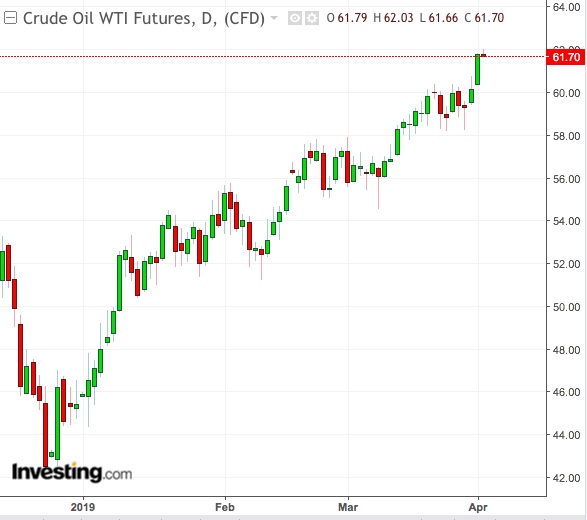Oil bears’ love affair with U.S. shale has fizzled for now.
After nearly five years of facilitating short-sellers who profited by keeping oil cheap, U.S. crude drillers have woken up, refusing to overproduce like before.
The U.S. oil rig count is falling week after week and production estimates by researchers in the government to Wall Street and the media show that new record highs in output may not be achieved as easily as before.
This is happening as bears already feel overwhelmed by a cocktail of bullish factors in oil that include relentless OPEC production cuts, rigid Trump administration sanctions on Venezuelan and Iranian oil and a virtually easy-money regime in the U.S., assured by a Federal Reserve determined not to hike interest rates like before.
A Perfect Storm For Oil Bears
Add to that the notion of better-than-expected recovery in China’s economy and oil demand this year, and the result is a perfect storm for traders and funds caught on the short side of the market.

New York-traded West Texas Intermediate, the benchmark for U.S. crude, is up 36% year-to-date, while its London peer Brent, the global gauge for oil, has gained 29%. Both are at five-month highs, with Brent just shy of OPEC kingpin Saudi Arabia’s target of $70 per barrel—which the Kingdom hopes will be triggered for its next aspiration of $80 and above.
John Kilduff, founding partner of New York energy hedge fund Again Capital, acknowledged that there’s zero incentive for the shale industry to collude with oil bears—when there’s more economic sense for it to play to the wishes of OPEC’s price hawks.
Yet, he believes the tight controls employed by U.S. drillers now—i.e. prioritizing cashflow and shareholder dividend over impulsive production ramp-ups that contributed to the market crashes of 2014-2016 and 2018—is a sign of the times.
Shale Drillers Pushed By Investors, Banks To Become Capital Generators
Said Kilduff:
“The shale guys are being squeezed by their investors and banks to become capital income generators.”
“It’s more like a delayed reaction on their part after the price collapse of late last year. They’ve circled the wagons and regrouped, realizing it’s just not in their best interest to add unnecessarily to activity. Unfortunately, those who’ll suffer most from that decision will be the oil bears.”
Whipsaw volatility in oil has rewarded both longs and shorts handsomely at intervals over the past five years, though it can be argued that the bears have profited more, given the frequency and intensity of the selloffs.
The trend may be shifting now.
Reuters’ oil columnist John Kemp noted on Monday that hedge funds have boosted their bullish position in six major crude contracts by a total of 421 million barrels over the last 11 weeks.
More Pain Coming Up For Bears?
Added Kemp:
“Prospects for rapidly slowing production growth and resilient consumption have removed the bearish bias in the market.”
Scott Shelton, energy futures broker at ICAP in Durham, N.C., also thought there could be more pain for oil bears in the near term as bullish Commodity Trading Advisors, or CTAs, take positions on the other side.
Said Shelton:
"I think this week could be a strong one for oil as there is physical support and also there could be some roll-yield chasing coming from the index world.”
"We could also see additional CTA buying as they have a ton of bullets to fire overall.”
Bloomberg said in a report that the dramatic surge in U.S. shale production over the past five years was running into a combination of technical and financial issues.
Schlumberger (NYSE:SLB) and Halliburton (NYSE:HAL), two of the largest providers of oil services, expect a double-digit drop in spending from drillers in the U.S. and Canada this year. Layoffs will also become more common, with Devon Energy (NYSE:DVN) set to slash its workforce by about a third due to pressure on spending.
On the technical end, there are problems caused by “interference” between newer oil sources—called "child wells"—and their "parent". Too close, and the child wells can turn out to be less prolific than their parent. Too far apart, and drillers can end up leaving oil in the ground.
Even so, Big Oil companies are getting excited about shale as smaller, independent drillers become more conservative. Exxon Mobil (NYSE:XOM) and Chevron (NYSE:CVX), for instance, have their sights on extracting an additional million barrels each from the Permian, the most productive shale basin.
New Pipelines Could Return Bears To Dependence On Shale
There is every chance for U.S. crude production to rebound later in the year when new pipeline capacity comes on stream to carry up to five million bpd of oil out of the shale basins, so that they can eventually be exported to Asia and elsewhere. U.S. crude exports hit a record 3.6 million bpd last month. Getting those up will be crucial to achieving government forecasts for record high production of above 13 million bpd by next year.
Kilduff believed that’s when U.S. drillers will be more inclined to completely turn the spigots on.
He said:
“The dependence of oil bears on shale to pressure prices isn’t over by any means. It’s just been delayed. With full-blown export potential, U.S. drillers will focus on volume rather than just price. Eventually, you’re going to see a V-shaped recovery in the production and rig count.”
